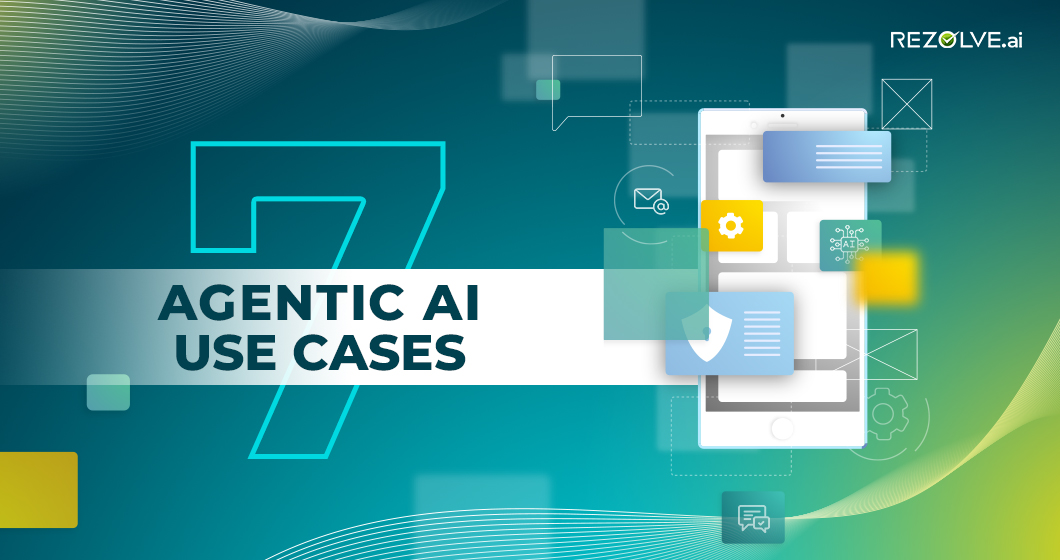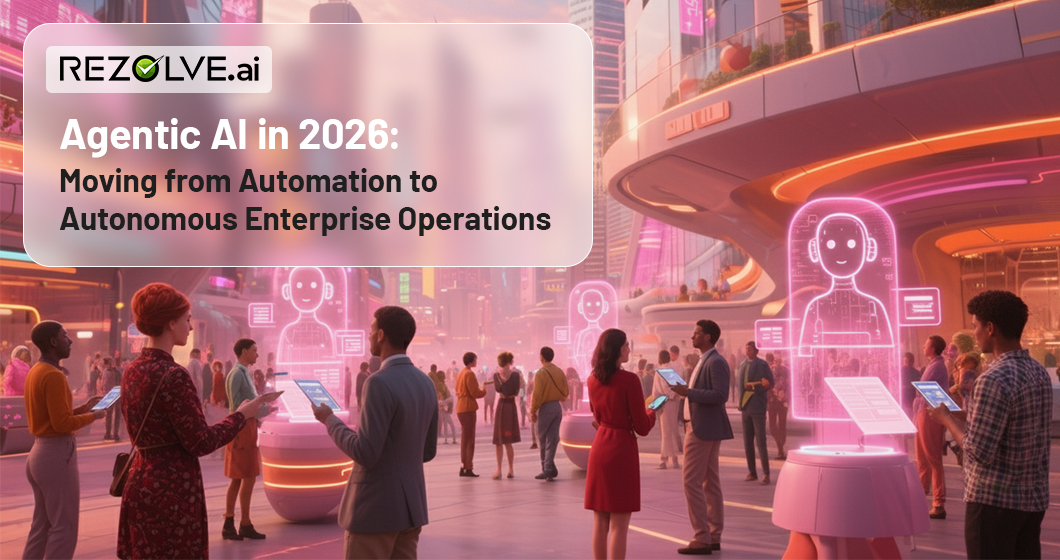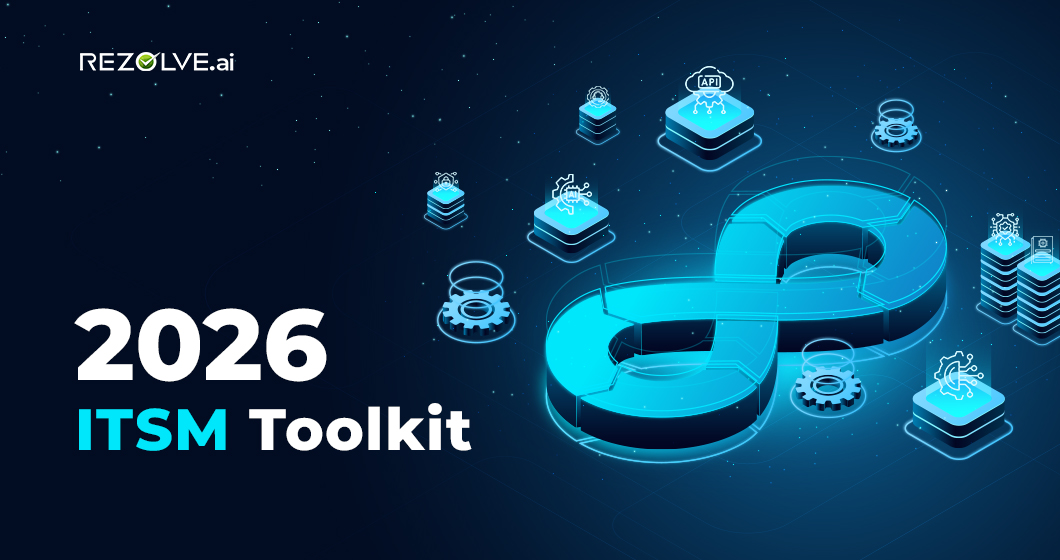Agentic AI is shifting enterprise automation from rule-bound to fully autonomous teammates. Gartner now projects that by 2028 one-third of commercial software will embed agentic capabilities, up from under 1 percent in 2024, letting machines shoulder about 15 percent of everyday decisions. The implications land first on high-volume support functions such as IT service management (ITSM) and the service desk, where seconds saved per ticket translate into millions of dollars and happier employees.
This blog unpacks exactly what makes agentic AI different and dives into seven concrete use cases already delivering measurable value. Let’s get started!
What Is Agentic AI?
Agentic AI describes systems that combine a sensory layer (logs, chat, APIs), a cognitive layer (planning, tool selection, guard-railed reasoning), and an action layer (secure execution) so they can pursue a goal end-to-end. Unlike predictive models that forecast the next number or generative models that draft content, an agent chooses what to do next and then does it.
Perception, Reasoning, Action
First, an agent ingests live signals – a burst of failed log-ins, a billing query in chat, an unexpected temperature spike on a factory motor. Next, it reasons: mapping the situation against policies, historical fixes, and risk thresholds. Finally, it acts by invoking scripts, APIs, or robotic process steps, and it loops until the goal is met. This continuous feedback cycle is why vendors from Microsoft to Salesforce are racing to add agentic layers on top of their copilots.
Self-Learning and Guardrails
Because every action produces new telemetry, agentic systems retrain themselves in context. Modern platforms pair that autonomy with guardrails – policy checks, audit trails, and human override – to satisfy security and compliance teams.
Why Agentic AI Matters for Modern Enterprises?
A service desk that never sleeps, learns from each resolution, and scales without hiring binges is more than a tech upgrade; it is a structural advantage.
Operational Efficiency
Agents banish manual triage queues, shrinking mean-time-to-resolve (MTTR) and eliminating the “swivel-chair” effort of hopping between portals. Forrester reports that early adopters cut incident backlogs by double digits while boosting system uptime.
Employee Experience
When employees get answers in the same Teams or Slack window where they asked, satisfaction scores climb. Rezolve.ai customers see CSAT jumps of 20-plus points after rolling out Agentic Sidekick 3.0’s in-chat resolutions.
Non-Linear Scalability
Because an agent can handle thousands of concurrent workflows, support capacity grows exponentially without matching headcount. That elasticity is pivotal for seasonal surges or merger integrations.
Governance and Trust
Autonomy is curbed by policy engines that log every step, enforce least-privilege access, and surface explain-as-you-go rationales – a prerequisite for audits and frameworks such as SOC 2 and GDPR.
Top 7 Real-World Agentic AI Use Cases
1. Autonomous IT Service Desk Agents
A modern agent plugs into monitoring tools, ticketing platforms, and collaboration chat to close incidents on its own.
How It Works
The agent parses an error, hunts KB articles, tests fixes on a sandbox, and if safe, executes them on the affected endpoint – all before the user refreshes their email.
Business Impact
Rezolve.ai customers report 30–70 percent auto-resolution of L1 tickets and MTTR cuts of up to 60 percent.
Example
A VPN outage alert fires at 2 a.m.; the agent rolls back the faulty certificate, reboots the service, notifies users, and documents the RCA, eliminating nights-and-weekends callouts.
2. Intelligent HR Support Agents
HR help desk volumes rival IT, yet most chatbots stop at FAQs.
Key Tasks
Agentic HR bots onboard new hires, unlock pay-stub access, update addresses in Workday, and trigger provisioning workflows in one conversation.
Employee Experience
Because answers arrive inside Teams, employees view HR as responsive instead of bureaucratic. Rezolve.ai’s HR module resolves up to 70 percent of requests instantaneously.
Example
One mid-market manufacturer saw onboarding cycle times drop from five days to under 24 hours after automating forms, badges, and laptop shipping through agents.
3. Finance Process Automation
Accounts payable and expense management drown in exceptions. Agentic AI removes the human bottleneck.
Core Workflows
Agents capture invoices, match them to POs, route approvals, and schedule payments while flagging anomalies such as duplicate vendor IDs.
Risk & Compliance Lens
Every step is logged and cross-checked against SOX or IFRS rules, slashing cycle-time while maintaining audit integrity.
ROI Snapshot
HighRadius estimates agentic AI cuts processing costs from $10.89 to under $3 per invoice and frees analysts for cash-flow strategy.
4. Cybersecurity Threat Detection & Response
Security operations centers battle alert fatigue; agentic AI reacts at machine speed.
Continuous Monitoring
Agents correlate logs, network flows, and endpoint telemetry to spot patterns a human might miss.
Rapid Containment
Platforms such as IBM’s autonomous SOC and CrowdStrike’s Charlotte AI isolate infected hosts, revoke credentials, and push patches in minutes.
Learning Loop
After remediation, the agent adds the IOC to threat models, improving precision with each incident.
5. Automated Change & Risk Management
Large IT environments push thousands of daily changes; missteps mean outages.
Predictive Change Assessment
Agents simulate proposed patches in digital twins, score blast radius, and suggest safer windows before CAB approval.
Compliance Safeguards
They cross-reference ITIL, ISO 27001, and sector-specific mandates, producing instant evidence for auditors.
Downtime Reduction
Early adopters report 30–40 percent fewer failed changes, saving millions in SLA penalties.
6. Knowledge Management & Retrieval
Most chatbots answer from a single source, leading to hallucinations. Agentic RAG (retrieval-augmented generation) blends and verifies data before responding.
Unified Knowledge Graph
Agents crawl SharePoint, Confluence, wikis, and ticket histories, weaving a semantic graph that updates daily.
Contextual Answers
When a user asks, “Why is my printer offline?”, the agent cites the exact driver doc, the last three incidents, and runs a fix script – all in one motion.
Measurable Gains
Companies adopting agentic RAG see 25-percent faster search times and 40-percent higher answer accuracy.
7. End-to-End Workflow Orchestration
The real magic appears when multiple agents collaborate across functions.
Cross-Department Playbooks
A single new-hire request triggers IT onboarding, HR paperwork, facilities seating, and finance asset booking without manual hand-offs.
Adaptive Sequencing
If equipment is out of stock, the workflow reprioritizes tasks, nudges procurement, and reschedules orientation automatically.
Industry Impact: Transforming ITSM & Service Desks
Traditional service management relied on runbooks and rigid workflows; agentic AI turns those playbooks into living organisms.
Speed and Consistency
Average handle time plunges because agents jump straight from detection to action, no queue required. Forrester highlights 24x7 agents as a cornerstone of “adaptive service management”.
Shift to Strategic Work
With L1 noise gone, IT staff tackle architecture, security hardening, and innovation. Organizations report 15–20 percent of engineer hours reallocated to strategic projects.
Metrics in Motion
First-contact resolution rates, SLA adherence, and employee NPS all rise while operating expense curves flatten – a virtuous cycle executives can take to the boardroom.
Rezolve.ai’s Role in the Agentic AI Revolution
Rezolve.ai was built for this moment, embedding Agentic Sidekick 3.0 natively in Microsoft Teams and Slack so employees never leave chat to get help.
Native Collaboration
Users describe an issue in natural language; the agent parses intent, checks policy, and executes the right action – whether resetting a password or provisioning Salesforce.
Agentic Core
Sidekick’s reasoning engine blends LLM understanding with policy graphs and a catalog of hundreds of vetted automations, all governed by SOC 2, HIPAA, and GDPR guardrails.
Results in Numbers
Deployments eliminate up to 70 percent of IT and HR tickets, cut MTTR by 60 percent, and spike CSAT by 25 points.
Closing Note
Agentic AI isn’t a shiny add-on; it is the next operating layer of the enterprise, turning static workflows into self-optimizing systems. Leaders who experiment now will own the playbooks others copy later. If you’re ready to see how autonomous, chat-first support can slash costs and thrill employees, schedule a demo of Rezolve.ai’s Agentic Sidekick 3.0 today – and let agentic AI do the heavy lifting.





.webp)




.jpg)

.png)








.png)